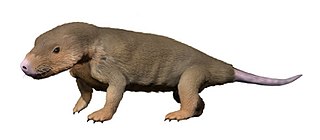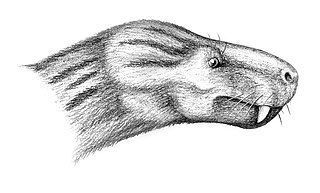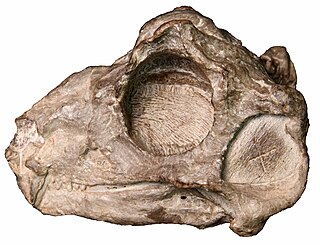 W
WAbdalodon is an extinct genus of late Permian cynodonts, known by its only species A. diastematicus. Abdalodon together with the genus Charassognathus, form the clade Charassognathidae. This clade represents the earliest known cynodonts, and is the first known radiation of Permian cynodonts.
 W
WAustralerpeton is an extinct genus of stereospondylomorph temnospondyl currently believed to belong to the family Rhinesuchidae. When first named in 1998, the genus was placed within the new family Australerpetontidae. However, studies published a few years later questioned the systematics used in the original description and included the genus within Archegosauridae. A study by Dias & Schultz (2003) reassigned Australerpeton to the family Rhinesuchidae within the suborder Stereospondyli based on an earlier evaluation of the family. In this study, the close similarities between Australerpeton and archegosaurids were attributed to convergent evolution as a result of similar semi-aquatic lifestyles. A redescription of the skeleton of this genus was published by Eltink & Langer in 2014, and the skull was redescribed in a follow-up study published by Eltink et al. in 2016. These studies, as well as a 2017 study focusing on rhinesuchids in general, confirmed that Australerpeton was a rhinesuchid rather than an archegosaurid. Fossils of the genus have been found in the Rio do Rasto Formation of Brazil.
 W
WCharassognathus is an extinct genus of Late Permian cynodonts. Described in 2007 from a locality near Fraserburg, South Africa, Charassognathus is the earliest and most basal cynodont. It is known only from the holotype, which dates from the Late Permian Period. The type and only species is C. gracilis. The holotype, found in the Tropidostoma Assemblage Zone of the Teekloof Formation, is made up of a crushed skull, partial lower jaw and one leg.
 W
WLende is an extinct genus of biarmosuchian from Malawi. It contains one species, Lende chiweta, first reported by Jacobs and colleagues in 2005 and is a burnetiamorph – a group of biarmosuchians characterized by numerous bosses and swellings on the skull. The type specimen was discovered in the early 1990s in the Permian Lower Bone Bed (B1) of the Chiweta Beds of Malawi, which are believed to correlate with the Cistecephalus Assemblage Zone of the South African Karoo Supergroup, the Usili Formation of Tanzania, and the Upper Madumabisa Mudstone of Zambia. The holotype of the genus Lende is MAL 290, which comprises an almost complete skull and lower jaw.
 W
WLeontosaurus is an extinct genus of non-mammalian synapsids from the Dicynodon Assemblage Zone, Balfour Formation of South Africa. It contains the single species L. vanderhorsti.
 W
WPeltobatrachus is an extinct genus of temnospondyl amphibian from the late Permian period of Tanzania.
 W
WProcynosuchus is an extinct genus of cynodonts from the Late Permian. It is considered to be one of the earliest and most basal cynodonts. It was 60 cm (2 ft) long and seems to have been adapted to a semi-aquatic lifestyle.
 W
WProtorosaurus is a genus of lizard-like early archosauromorph reptiles. Members of the genus lived during the late Permian period in Germany and Brazil. Once believed to have been an ancestor to lizards, Protorosaurus is now known to be one of the oldest members of the lineage that would eventually lead to archosaurs such as crocodilians and dinosaurs.
 W
WRhineceps is an extinct genus of temnospondyl amphibian in the family Rhinesuchidae. Rhineceps was found in Northern Malawi in Southern Africa known only from its type species R. nyasaensis. Rhineceps was a late Permian semi-aquatic carnivore that lived in streams, rivers, lakes or lagoons. Rhineceps is an early divergent Stereopondyl within the family Rhinesuchidae, which only existed in the late Permian (Lopingian) and failed to survive the Permian-Triassic extinction unlike other stereospondyl families.
 W
WScutosaurus was a genus of parareptiles. It was an armor-covered pareiasaur that lived around 265–254 million years ago in Russia, in the later Permian period. Its genus name refers to large plates of armor scattered across its body. It was a large anapsid reptile that, unlike most reptiles, held its legs underneath its body to support its great weight. Fossils have been found in the Sokolki Assemblage Zone of the Malokinelskaya Formation in European Russia, close to the Ural Mountains.